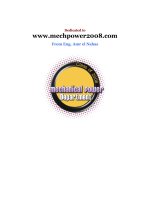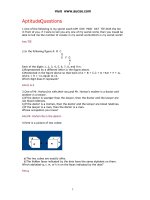The quality management questions and answers - UEF
Bạn đang xem bản rút gọn của tài liệu. Xem và tải ngay bản đầy đủ của tài liệu tại đây (74.4 KB, 10 trang )
Q1)
What is Quality Management?
Quality management is the act of overseeing all activities and tasks that must be accomplished to
maintain a desired level of excellence. This includes the determination of a quality policy,
creating and implementing quality planning and assurance, and quality control and quality
improvement. It is also referred to as total quality management (TQM)
Source: Quality Management Definition (investopedia.com)
Q2)
Define Total Quality Management. Explain how important of TQM in a coffee store
chain and provide examples
Total quality management (TQM) is the continual process of detecting and reducing or
eliminating errors in manufacturing, streamlining supply chain management, improving the
customer experience, and ensuring that employees are up to speed with training. Total quality
management aims to hold all parties involved in the production process accountable for the
overall quality of the final product or service.
Starbucks Quality Management Key requirements, capabilities and challenges.
The key operations requirements for Starbucks to achieve excellence in the quality management
framework includes may be maintaining high levels of product and service quality. The rising
levels of competition in the coffee industry has fuelled the level of clients expectations on
product fleshiness and quality. From the operations assessment, it is evident that Starbuckss has a
robust and highly efficient quality management system which incorporates best management
approaches and practices in its operations. Through the logistics and distribution analysis,
starbuck has far reaching distribution channels that helps in reducing redundancy as well as
maximizing business operations efficiency (Rodrigo,2012). Starbucks has a fine quality control
[process which helps in delivering high quality products ad services. The products offered are
exclusively customer driven and are normally produced based o the clients tastes and preferences
thus attracting customers to purchase the products .In order t0 achieve produce high quality
products, Starbuckss incorporates a wide range of initiatives including checking on the quality
measures involved the production of coffee beans from the farms.
Despite of the extensive success factors in Starbucks quality management strategies, the
company also experience some challenges associated with the quality management processes.
Among the presenting challenges include responding to changing customer need. Since its
initiation, Starbucks has proven an outstanding ability in recognizing the needs of different
customers. The company always seeks to mot only provide the customer with a beverage but
and experience in an effort to make starbuck “third place between work and home which have ”
have separated Starbucks from other coffeehouse chains. These experiences are shaped from
different tastes, flavors and even packaging designs and in order to sustain the clients, the
companies needs to adapt to these customers needs and preferences’ he other challenge facing
starbuck is m poor
Q3)
“The Four Ps and Three Cs form is the basis of a simple model for TQM to take
organizations successfully into the twenty-first century”. Explain your understanding
about statement with examples in a business.
These ‘four Ps’ form the basis of a simple model for TQM and provide the ‘hard management
necessities’ to take organizations successfully into the twenty-first century. From the early TQM
frameworks, however, we must not underestimate the importance of the three Cs – Culture,
Communication and Commitment. The new TQM model is complete when these ‘soft outcomes’
are integrated into the four P’s framework to move organizations successfully forward
This new TQM model, based on all the excellent work done during the last century, provides a
simple framework for excellent performance, covering all angles and aspects of an organization
and its operation.
Performance is achieved, using a business excellence approach, and by planning the
•
involvement of people in the improvement of processes. This has to include:
Planning – the development and deployment of policies and strategies; setting up appropriate
•
partnerships and resources; and designing in quality.
Performance – establishing a performance measure framework – a ‘balanced scorecard’ for the
•
organization; carrying out self-assessment, audits, reviews and benchmarking.
Processes – understanding, management, design and redesign; quality management systems;
continuous improvement.
•
People – managing the human resources; culture change; teamwork; communications; innovation
and learning.
Wrapping around all this to ensure successful implementation is, of course, effective
leadership and commitment
Explain your understanding of statements with examples in a business.
The principle of Focusing on Customer. This is the basis of companies such as Walmart, which
are totally focused on offering 100% customer satisfaction in every interaction.
Employee involvement. Companies such as Home Depot offer continual training to offer
employees tools to interact with customers.
Process centered. It is at the core of a "well-oiled" organization that has complicated operations.
An example could be Federal Express's operations in their hubs.
Strategic approach. Insurance companies such as Met-Life had to implement good strategies to
open new markets successfully.
Decision making. Tough decisions must be made almost on a daily basis. That is why companies
such as Tesla keep the company as an attractive one to invest in it.
Communications. This is the basis of any company's success. Starbucks is known to promote
open lines of communication between employees and managers, in order to understand the
necessities of the company.
Total Control. The constant effort to improve, no matter the conditions or the presence in the
market. The NFL is a great example of trying to change and innovate year after year.
Q4)
Define cost of quality (COQ) and its importance in quality management. Figure out
components of COQ with their examples.
Cost of quality is a method for calculating the costs companies incur ensuring that products meet
quality standards, as well as the costs of producing goods that fail to meet quality standards. The
necessary activities will incur costs that may be separated into prevention costs, appraisal
costs and failure costs. Failure costs can be further split into those resulting from internal and
external failure.
Prevention costs:
These are associated with the design, implementation and maintenance of the quality
management system. Prevention costs are planned and are incurred before actual operation
Examples include new product review, quality planning, supplier surveys, process reviews,
quality improvement teams, education and training.
Appraisal Costs:
These costs are associated with the supplier’s and customer’s evaluation of purchased
materials, processes, intermediates, products and services to assure conformance with the
specified requirements
Examples include inspection, testing, process or service audits, calibration of measuring and test
equipment.
Internal failure costs:
These costs occur when the results of work fail to reach designed quality standards and are
detected before transfer to the customer takes place
Examples include scrap, rework, re-inspection, re-testing, material review, material downgrades.
External Failure Costs:
These costs occur when products or services fail to reach design quality standards but are not
detected until after transfer to the consumer
Examples include processing customer complaints, customer returns, warranty claims, product
recalls.
Q5)
Compare the ‘quality gurus’ in America, Deming, Juran and Crosby. Provide some
examples to prove the differences in their theory.
Definition of quality
•
Deming implicitly defines quality as "zero defects" or "reduced variation.
•
Juran defines quality as "fitness for use." Fitness for use can be thought of in terms of
design, conformance, availability, safety, and field use. Of the three definitions, it most directly
incorporates the customer's point of view.
•
Crosby defines quality as "conformance to requirements.
Cost, Productivity, and Competitive Success
•
For Deming, the pursuit of quality results in lower costs, improved productivity, and
competitive success.
•
Juran has developed analytical tools which lead to improved productivity and
competitive success. But his cost of quality accounting system suggests that the pursuit of quality
pays for itself only up to a certai point, and beyond that point leads to rising costs.
•
Crosby believes that quality is free. This suggests that lower defect levels are always
desirable, because the costs of prevention will always be lower than the costs of after-the-fact
detection and correction. He also believes U.S. companies have lo improve quality lo compele.
His itlea that preventiom meas perfestiom implies improved productivity.
Three Major Contrasts
•
How does each regard quantitative measures and standards? Deming relies on statistical
process control (SPC) as a problem-solving tool which separates systemic causes from special
causes, but is unwilling to set quantitative goals for the work force. Juran is prepared to measure
and quantify everything trom conformance, to risk of injury due to product hazards, to the cost of
quality. Crosby, on the other hand, is far more interested in motivation than measures although he
does suggest the need for cost of quality measurehent system
•
How does each regard the relative responsibilities of upper management, quality
professionals, and the work force? All three experts agree on major roles for upper management.
But only Juran sees a central role for quality professionals who assist top management with
planning, measurement, and problem solving.Deming stresses the value of the
worker/management relationship and feels that workers themselves should be responsible for
problem solving, once they are properly trained. Crosby is also a believer in training and
motivating workers, but he counts on them to communicate problems to the next levels of
management rather than to solve problems themselveş.
•
How does each deal with targets for improvement? Deming and Crosby basically agree
on the need for the ongoing pursuit of zero defects as a goal. But Hote on Quality: The Views of
Deming, Juran, and Crosby 691-022 Juran's COQ concept suggests to companies that it is
increasingly costly to take the final steps to perfection
Q6)
Explain the difference between quality and reliability; and between quality of design
and quality of conformance.
Quality and reliability
Quality is meeting the customer requirements, and this is not restricted to the functional
characteristics of the product or service.
Reliability is the ability of the product or service to continue to meet the customer requirements
over time.
Quality is a much broader aspect than Reliability. Quality covers almost everything from
organisation, managements, service, procedures, people, product, product-life etc. In simple
words, Reliability is only a subset of quality, the others being performance, consistency,
efficiency, user experience etc. Whereas Quality is the measure of conformance to laid down
product specification
We will take an example: Suppose, you went to a shop to buy oranges. If the orange is good or
bad, that measure is quality. You took the oranges that day and returned to home. Next day you
again visited the same shop to buy oranges and found that the oranges available there are good
again. You purchased it and returned to your home. You repeated the same process for one week
and every time you got good oranges. Now, you have a trust on that shop that you will always
get good oranges there, and that’s Reliability.
Quality of design and quality of conformance
Quality of design is a measure of how well the product or service is designed to achieve the
agreed requirements
Quality of conformance is the level of the quality of product actually produced and delivered
through the production or service process of the organization as per the specifications or design.
When the quality of a product entirely conforms to the specification (design), the quality of
conformance is deemed excellent.
Q7)
What requirements for effective leadership in an organization? Describe how you
would go about helping a senior management team in a hospital gain the commitment
of the medical, nursing and administration staff to deliver quality health services to the
local community.
Efffective leadership starts with the chief executive’s and his top team’s vision, capitalizing on
market or service opportunities, continues through a strategy that will give the organization
competitive or other advantage, and leads to business or service success. It goes on to embrace
all the beliefs and values held, the decisions taken and the plans made by anyone anywhere in the
organization, and the focusing of them into effective, value-adding action.
Together, effective leadership and total quality management result in the company or
organization doing the right things, right first time. Total Quality Management The five
requirements for effective leadership are the following:
1. Developing and publishing clear documented corporate beliefs and purpose – a mission
2.
3.
4.
5.
statement
Develop clear and effective strategies and supporting plans for achieving the mission
Identify the critical success factors and critical processes
Review the management structure
Empowerment – encouraging effective employee participation
Q8)
Describe the key stages of integrating total quality into the strategy of an
organization of your choice
There are six basic steps also key stages for achieving this and providing a good foundation for
the implementation of TQM
1. Develop a shared vision and mission for the business/organization: Once the top team is
reasonably clear about the direction the organization should be taking it can develop
vision and mission statements that will help to define process-alignment, roles 48 Total
Quality Management and responsibilities
2. Develop the ‘mission’ into its critical success factors (CSFs) to coerce and move it
forward: The development of the mission is clearly not enough to ensure its
implementation. This is the ‘danger gap’ which many organizations fall into because they
do not foster the skills needed to translate the mission through its CSFs into the core
processes
3. Define the key performance outcomes as being the quantifiable indicators of success in
terms of the mission and CSFs: The mission and CSFs provide the what of the
organization, but they must be supported by measurable key performance outcomes
(KPOs) that are tightly and inarguably linked. These will help to translate the directional
and sometimes ‘loose’ statements of the mission into clear targets, and in turn to simplify
management’s thinking
4. Understand the core processes and gain process sponsorship: This is the point when the
top management team have to consider how to institutionalize the mission in the form of
processes that will continue to be in place, until major changes are required.
5. Break down the core processes into subprocesses, activities and tasks and form
improvement teams around these: Once an organization has defined and mapped out the
core processes, people need to develop the skills to understand how the new process
structure will be analyzed and made to work
6. Ensure process and people alignment through a policy deployment or goal translation
process: One of the keys to integrating excellence into the business strategy is a formal
‘goal translation’ or ‘policy deployment’ process. If the mission and measurable goals
have been analyzed in terms of critical success factors and core processes, then the
organization has begun to understand how to achieve the mission
Q9)
What are the prerequisites of TQM? Discuss the barriers in implementing the TQM
program with some examples
The prerequisites of TQM
•
•
•
•
•
•
Commitment from the management
Employee Empowerment
Continuous Improvement
Customer Focus
Process Oriented
Decision Making Based on Facts Only and Not on Opinions
The barriers in implementing the TQM program:
1. Lack of management commitment: In order for any organizational effort to succeed, there
must be a substantial management commitment of management time and organizational
resources. The purpose must be clearly and continuously communicated to all personnel
management must consistently apply the principle of TQM
2. Inability to change organizational culture: Changing an organization's culture is difficult and
will require as much as five years. Individuals resist change--they become habituated to doing a
particular process and it becomes the preferred way. Management must understand and utilize
the basic concepts of change.
3. Improper planning: All constituents of the organization must be involved in the development
of the implementation plan and any modifications that occur as the plan evolves. The Two-way
communication of ideas is the matter of great importance and should be taken by all personnel
during the development of the plan and its implementation. Customer satisfaction should be the
goal rather than financial or sales goals.
4. Lack of continuous training and education: Training and education is an ongoing process for
everyone in the organization. Needs must be determined and a plan developed to achieve those
needs.
5. Incompatible organizational structure and isolated individuals and departments: Difference
between departments and individuals can create implementation problems. The use of
multifunctional teams will help to break down long-standing barriers. Restructuring to make the
organization more response to customer needs may be needed
6. Ineffective measurement techniques and lack of access to data and réults: Key characteristics
of the organization should be measured for effective decision making. To improve a process are
you need to measure the effect of improvement ideas. Access to data and quick retrieval is
necessary for effective processes.
7. Paying inadequate attention to internal and external customers: Organizations need to
understand the changing needs and expectations of their customers. Effective feedback
mechanism that provide data for decision making are necessary for this understanding.
8. Inadequate use of empowerment and team work
Teams need to have the proper training and at least in the beginning by a facilitator. Individuals
should be empowered to make decisions that affect the efficiency of their process or the
satisfaction of their customer.
9. Failure to continuously improve
It is tempting to sit back and rest on your laurels. However, a lack of continuous improvement of
the process, product and service will even leave the leader of the pack in the dust.
Q10) Explain what you understand by the term ‘Total Quality Management’, paying
particular attention to the following terms: quality, supplier/customer interfaces,
process.
Q11) Define Total Quality Management?
TQM is an enhancement to the traditional way of doing business. It is the art of managing the
whole to achieve excellence. It is defined both a philosophy and a set of guiding principles that
represent the foundation of a continuously improving organization. It is the application of
quantitative methods and human resources to improve all the processes within an organization
and exceed customer needs now and in the future. It integrates fundamental management
techniques, existing improvement efforts, and technical tools under a disciplined approach.
Q12) What are the Dimensions of Quality?
Performance, Features, Conformance, Reliability, Durability, Service, Response, Aesthetics,
Reputation









